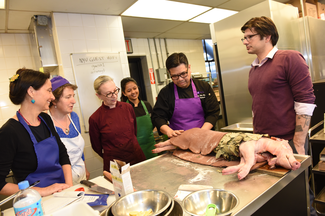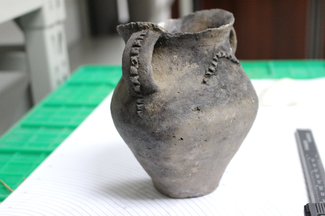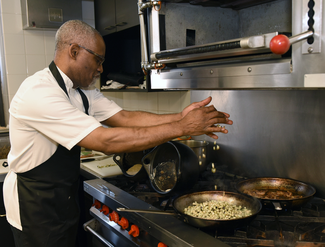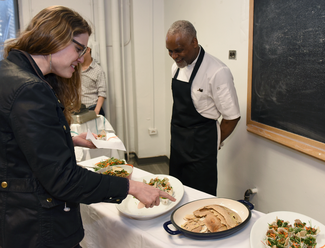Appetite for the Past, April 30 - May 1, 2018
A conference organized by Yitzchak Jaffe, Visiting Assistant Professor, and Kelila Jaffe, Chef, Archaeologist, and PhD Student (Department of Nutrition and Food Studies, NYU).
Article by Candida Moss, Research Associate; a version first appeared in The Daily Beast on May 5, 2018.
This article first appeared in ISAW Newsletter 21 (Spring 2018).
 Nicholas Vogt (Indiana University) and Chef Wai Hon Chu (ICE and NYU) recre-ate a Han-dynasty era “bake” (Bao 炮) of suckling pig.
At the Last Supper Jesus told his disciples that he was about to be betrayed by one of those present. Shocked, they asked him who the person was. “It is one of the 12 who is dipping bread into the bowl with me.” He’s talking about Judas, of course. The shock value of his statement hinges on an unlikely plot device: a small dish of “dip,” which drives home the point that Jesus was betrayed by one of his closest companions.
Nicholas Vogt (Indiana University) and Chef Wai Hon Chu (ICE and NYU) recre-ate a Han-dynasty era “bake” (Bao 炮) of suckling pig.
At the Last Supper Jesus told his disciples that he was about to be betrayed by one of those present. Shocked, they asked him who the person was. “It is one of the 12 who is dipping bread into the bowl with me.” He’s talking about Judas, of course. The shock value of his statement hinges on an unlikely plot device: a small dish of “dip,” which drives home the point that Jesus was betrayed by one of his closest companions.
But what was this mysterious dish? Other than much-publicized bread and wine, which have gone on to be celebrated as part of the Eucharist in Christian churches around the world, this condiment was the last thing that Jesus chose to eat. So what did it taste like?
The most probable answer is that it was garum, an ancient kind of fish sauce that was used throughout the Roman Empire by rich and poor alike. This spring semester, a collaboration between ISAW Visiting Assistant Professor Yitzchak Jaffe and chef Kelila Jaffe (no relation) of NYU’s Nutritional Science department brought together an international team of chefs and scholars together to recreate garum and a host of other ancient dishes.
 A team presents a recreation of a Babylonian lamb-and-beet stew
Food and food habits are a key marker of identity. It defines where, how, and what you eat, which, in turn, determines when and with whom you can socialize. At the same time, historically speaking, when we come into contact with other groups it is often the other group’s food that slips unannounced into our cultural repertoire. Classicist Gregory Woolf wrote in his seminal study of Roman Gaul (France) that in the Roman empire food and wine spread more quickly than other cultural markers such as language and clothing. In other words, we are willing to eat novel food before we start dressing differently and becoming bilingual.
A team presents a recreation of a Babylonian lamb-and-beet stew
Food and food habits are a key marker of identity. It defines where, how, and what you eat, which, in turn, determines when and with whom you can socialize. At the same time, historically speaking, when we come into contact with other groups it is often the other group’s food that slips unannounced into our cultural repertoire. Classicist Gregory Woolf wrote in his seminal study of Roman Gaul (France) that in the Roman empire food and wine spread more quickly than other cultural markers such as language and clothing. In other words, we are willing to eat novel food before we start dressing differently and becoming bilingual.
For some of those involved at the conference “Appetite for the Past,” it wasn’t at all clear that the recipes would actually work. Nicholas Vogt of Indiana University thought it possible that his Han-dynasty era recipe was the invention of an author who had likely never stepped foot in a kitchen. His partner, chef Wai Hon Chu, helped him recreate a “bake” of suckling pig that they described as pretty delicious. The recipe required some supplementation, but it demonstrated that the elite author had gone to the trouble to talk to chefs about how to cook this dish.
 A vessel found in an ancient Chinese cemetery which contains puzzling scorched patterns
In some cases the scientific process of cooking actually helped the scholars involved understand the history better. The team working on Babylonian recipes encountered some that were only a few sentences long. A situation like this poses all kinds of methodological questions for the chefs: can we be sure that we know what the listed ingredients actually are?
A vessel found in an ancient Chinese cemetery which contains puzzling scorched patterns
In some cases the scientific process of cooking actually helped the scholars involved understand the history better. The team working on Babylonian recipes encountered some that were only a few sentences long. A situation like this poses all kinds of methodological questions for the chefs: can we be sure that we know what the listed ingredients actually are?
How do we know how these ingredients were actually prepared? And should food be seasoned if seasoning is not listed in the recipe? In these situations, Harvard senior preceptor and chemist Pia Sörensen told me, the science can help us understand how an ingredient was used in ancient cooking. Knowledge about how the human taste buds react to sour and sweet tastes can help the investigators ascertain if they are on the right track. One recipe for stew called for the use of soapwort, but trial runs in the kitchen revealed that it was just too bitter to be incorporated into the dish as it was. In the end they made the surprising discovery that soapwort is a potent emulsifier and used it to blend the dish more effectively. It’s a revelation that might actually have applicability in kitchens today.
 Chef Childs recreates the millet-pork stew.
In other cases the culinary arts can rescue an artifact from obscurity. Ordinarily archaeologists who study pottery spend much of their time trying to figure out who made the jars, pots, and ceramics discovered at a particular location. Jaffe realized how intrinsically flawed this method is: “Imagine that in the future archaeologists argued that anyone who used IKEA cookware was Swedish.” Instead he wanted to know something else: how were these vessels used? His project “What Did Barbarians Eat?” involved trying to reproduce the burn marks scorched into ancient earthenware from Zhou Dynasty China. In the process of their experiments, he and partners Raymond Childs (Chef, ISAW) and Karine Taché (Assistant Professor, Anthropology, Queens College-CUNY) used chemical analysis and trial and error to discover that pots were designed to be placed into the flames on their side, a method that allowed for greater flexibility of use. Among other dishes, the team was able to cook millet crackers inside the rim of the pots.
Chef Childs recreates the millet-pork stew.
In other cases the culinary arts can rescue an artifact from obscurity. Ordinarily archaeologists who study pottery spend much of their time trying to figure out who made the jars, pots, and ceramics discovered at a particular location. Jaffe realized how intrinsically flawed this method is: “Imagine that in the future archaeologists argued that anyone who used IKEA cookware was Swedish.” Instead he wanted to know something else: how were these vessels used? His project “What Did Barbarians Eat?” involved trying to reproduce the burn marks scorched into ancient earthenware from Zhou Dynasty China. In the process of their experiments, he and partners Raymond Childs (Chef, ISAW) and Karine Taché (Assistant Professor, Anthropology, Queens College-CUNY) used chemical analysis and trial and error to discover that pots were designed to be placed into the flames on their side, a method that allowed for greater flexibility of use. Among other dishes, the team was able to cook millet crackers inside the rim of the pots.
This kind of ground-breaking work is important because it provides another route into the past. As Leon Levy Director Alexander Jones said at the beginning of the symposium, most of the time historians learn about the past using their eyes, but taste and smell can give us a window into the past that reading cannot. Understanding the labor, smells, and sensory experience of people in the past can better help us understand who they were, what they valued, and how they lived.
 Chef Childs presents his reimagined Siwa recipe with carrots and apricots served with millet crackers
The part of this project that was altogether unprecedented was the organizer’s insistence that chefs be involved from the beginning to the end of the process. Jaffe told me: “Archaeologists, in a sense, study everything about the world today, yesterday. Economy, politics, religion family relationships social class, science, fashion, art psychology; you name it! And to do that we consume (no pun intended) theoretical perspectives from each one of these fields and do our best to collaborate with their experts. Shouldn’t we be working with chefs then to help us look at early foodways as well? I, for one, learned a whole lot of humility and appreciation for chefs and their incredible knowledge.”
Chef Childs presents his reimagined Siwa recipe with carrots and apricots served with millet crackers
The part of this project that was altogether unprecedented was the organizer’s insistence that chefs be involved from the beginning to the end of the process. Jaffe told me: “Archaeologists, in a sense, study everything about the world today, yesterday. Economy, politics, religion family relationships social class, science, fashion, art psychology; you name it! And to do that we consume (no pun intended) theoretical perspectives from each one of these fields and do our best to collaborate with their experts. Shouldn’t we be working with chefs then to help us look at early foodways as well? I, for one, learned a whole lot of humility and appreciation for chefs and their incredible knowledge.”
Chefs can teach archaeologists a thing or two about the past.